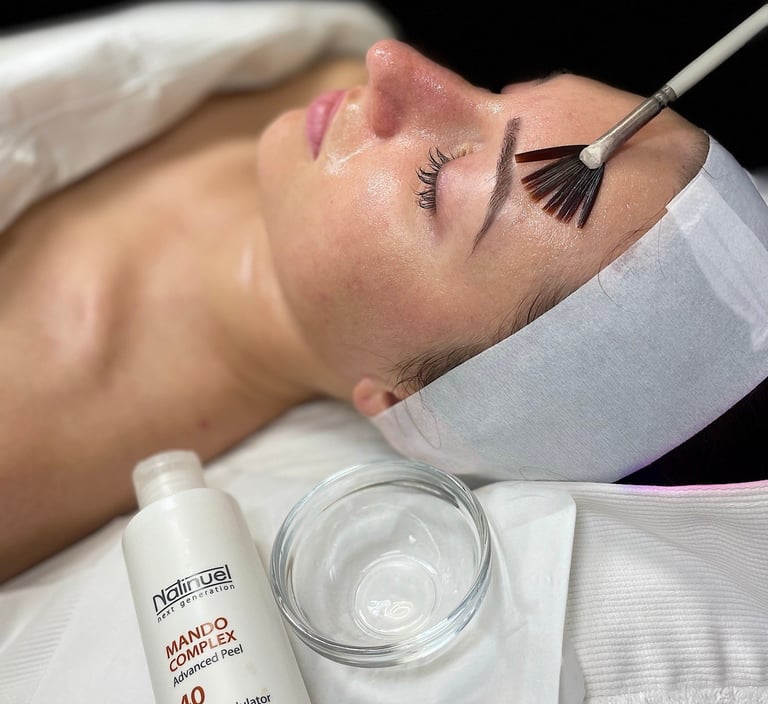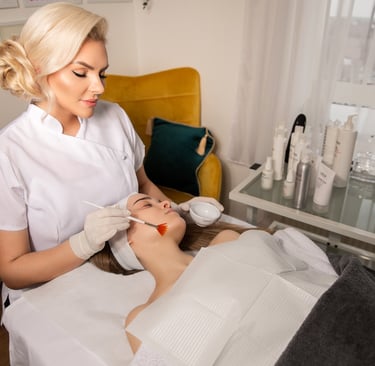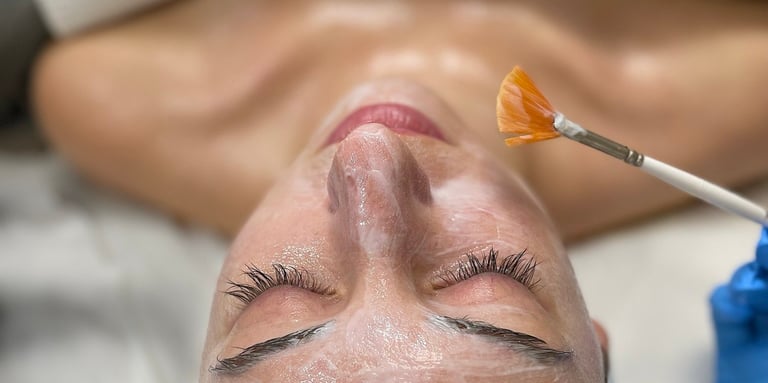

Chemical Peels
Chemical peels are a skin resurfacing procedure that involves the application of a chemical solution to the skin to exfoliate and remove the damaged outer layers. This treatment can improve the skin’s appearance by reducing wrinkles, scars, and discoloration.
Chemical peels are an effective cosmetic treatment to rejuvenate and improve the skin's appearance. By removing damaged outer layers, chemical peels can address various skin concerns, including wrinkles, scars, and pigmentation issues. The procedure involves the application of a chemical solution tailored to the patient’s needs, with specific aftercare to ensure proper healing and optimal results. Regular maintenance and sun protection are essential to maintain the benefits of the treatment.
Benefits of Chemical Peels
Skin Rejuvenation: Improves skin texture, tone, and overall appearance.
Acne and Scarring: Reduces acne and the appearance of acne scars.
Pigmentation: Helps diminish hyperpigmentation, sun spots, and melasma.
Fine Lines and Wrinkles: Softens the appearance of fine lines and wrinkles.
Potential Side Effects
Common Side Effects: Redness, dryness, peeling, and temporary skin sensitivity.
Rare Complications: Infection, scarring, changes in skin colour (hyperpigmentation or hypopigmentation), and adverse reactions to the chemical solution.


1. Consultation
Assessment: A qualified dermatologist or aesthetic practitioner assesses the patient’s skin type, concerns, and desired outcomes. This includes a thorough review of the patient’s medical history, skin conditions, and any contraindications.
Treatment Plan: A personalized treatment plan is developed, specifying the type of chemical peel (superficial, medium, or deep) suitable for the patient, the number of sessions required, and targeted areas.
2. Preparation
Skin Cleansing: The treatment area is thoroughly cleansed to remove any impurities, oils, and makeup.
Pre-Treatment Skincare: Patients may be advised to follow a pre-treatment skincare regimen for a few weeks to prepare the skin and enhance the peel’s effectiveness. This often includes the use of specific creams or serums.
3. Chemical Peel Application
Protective Measures: Eye protection (goggles or gauze) is provided, and hair is secured to prevent contact with the peel solution. A barrier ointment may be applied to sensitive areas like the lips and nostrils.
Application Technique:
Superficial Peel: A mild acid, such as alpha-hydroxy acid (AHA), is applied using a brush, cotton ball, or gauze. The solution is left on the skin for a few minutes before being neutralized and washed off.
Medium Peel: A stronger acid, such as trichloroacetic acid (TCA), is applied in a similar manner. The solution penetrates deeper into the skin. It may be left on for a longer period and requires more careful monitoring.
Deep Peel: A potent acid, like phenol, is used. This type of peel requires a more extended recovery period and is usually performed in a medical setting with local anesthesia or sedation. The solution is applied and may remain on the skin for a significant amount of time before being neutralized and removed.
4. Post-Treatment Care
Immediate Aftercare: The treated area may be rinsed with cool water and neutralized if necessary. A soothing ointment or moisturizer is often applied to promote healing and comfort.
Aftercare Instructions: Patients receive detailed aftercare instructions, including:
Moisturization: Regular application of a gentle moisturizer to keep the skin hydrated.
Sun Protection: Avoiding sun exposure and using a broad-spectrum sunscreen with high SPF to protect the sensitive, healing skin.
Avoidance of Irritants: Refraining from using harsh skincare products or treatments that can irritate the skin.
5. Results and Follow-Up
Initial Effects: The skin may appear red and feel tight immediately after the procedure. Peeling and flaking typically begin within a few days.
Full Results: Optimal results develop over several weeks as new, healthier skin emerges. The skin appears smoother, more even-toned, and rejuvenated.
Maintenance Sessions: Depending on the type of peel and individual goals, follow-up sessions may be recommended to maintain results. Superficial peels may be done more frequently, while medium and deep peels are performed less often.


